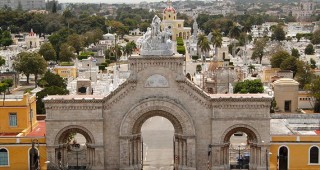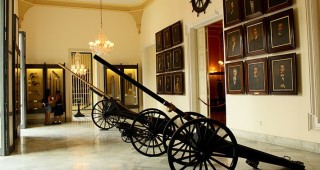This is the studio-gallery of ceramicists Amelia Carballo and Ángel Norniella. Their work shows a wide variety of influences and techniques, including the millenary raku, and as the name suggests focus on terra-cotta artwork and crafts.

Callejón de Hamel LH  5+
5+
The narrow two-block long alley between Aramburu and Hospital streets in Centro Habana has over the years become a shrine to Afro-Cuban religions through the art created by Salvador González. The buil …

Necrópolis de Cristóbal Colón LH  5+
5+
History & architecture Declared National Monument in 1987, this is the most important cemetery in Cuba and its 57 hectares (10 acres) makes it the largest in America. According to Enrique Martínez …
 EclecticAdmission: CUC 1Open: 9am-5pm dailyZapata y 12
EclecticAdmission: CUC 1Open: 9am-5pm dailyZapata y 12 
Catedral de La Habana LH  5+
5+
The entry of the Jesuits in Cuba was formally requested in 1656, and in 1727, a plot was granted for their school and church. Bishop Brother Gerónimo Valdés explained to the King of Spain that Havana’ …
 BaroqueAdmission: FreeOpen: 10:30am-3pm Mon-SunEmpedrado #156 e/ San Ignacio y Mercaderes, Habana Vieja
BaroqueAdmission: FreeOpen: 10:30am-3pm Mon-SunEmpedrado #156 e/ San Ignacio y Mercaderes, Habana Vieja 
The Malecón LH  5+
5+
The Malecón, first named Avenida del Golfo, is Cuba’s most famous sea-side avenue. The project was undertaken by Don Francisco de Albear, Cuba’s greatest engineer at the time. Albear came up with a co …

Museo de la Ciudad (Palacio de los Capitanes Generales) LH  5
5
History & architecture Considered the most important example of baroque architecture in the city, this grand building on the west side of the plaza was built in 1792, on the sight of the former pa …
 BaroqueAdmission: CUC 3Open: 9am-6pm dailyCuba e/ Obispo y O’Reilly, Habana Vieja
BaroqueAdmission: CUC 3Open: 9am-6pm dailyCuba e/ Obispo y O’Reilly, Habana Vieja 
Iglesia de San Francisco de Paula LH  5
5
In 1664 the Presbyter of the Cathedral of Havana, don Nicolás Estévez Borges, ordered the construction of a chapel devoted to Saint Francis of Paola (founder of the Roman Catholic Order of the Minims) …
 BaroqueAdmission: FreeAvenida del Puerto, esq. a San Ignacio, Habana Vieja
BaroqueAdmission: FreeAvenida del Puerto, esq. a San Ignacio, Habana Vieja 
Iglesia de Jesús de Miramar LH  5
5
Opened in 1953, this is Cuba’s second largest church, which is visible for several blocks due to its vast dome built in Roman-Byzantine style. The Jesús de Miramar church boasts 14 large mural paintin …
 OtherOpen: 9am-noon, 4-6pm daily; Mass: 9am Mon-Fri; 9am, 5pm Sat-Sun; To visit at other times, enter via the sacristy5ta #8003 entre 80 y 82
OtherOpen: 9am-noon, 4-6pm daily; Mass: 9am Mon-Fri; 9am, 5pm Sat-Sun; To visit at other times, enter via the sacristy5ta #8003 entre 80 y 82 
Edificio Bacardí LH  5
5
The first and main exponent of art deco in the city belonged to Emilio Bacardí and was the home to his famous rum company. After winning the contest held by Bacardí, architects E. Rodríguez, R. Fernán …
 Art DecoAdmission: FreeOpen: 9am-9pm dailyMonserrate esq. a San Juan de Dios, Habana Vieja
Art DecoAdmission: FreeOpen: 9am-9pm dailyMonserrate esq. a San Juan de Dios, Habana Vieja 
Hostal Conde de Villanueva LH  4
4
The former 18th-century mansion of Claudio Martínez de Pinillos, Count of Villanueva, leader of Cuban Creole society in the 19th century, was restored in the 1990s to create a charming and comfortable …
 ColonialAdmission: n-aMercaderes #202, e/ Lamparilla y Amargura, Habana Vieja
ColonialAdmission: n-aMercaderes #202, e/ Lamparilla y Amargura, Habana Vieja 
Museo del Ferrocarril LH  4
4
Opened on November 19, 2002, the Railway Museum is housed in the former Cristina railway station, headquarters of the Western Railway of Havana. Cuba was the sixth country in the world to develop a ra …






